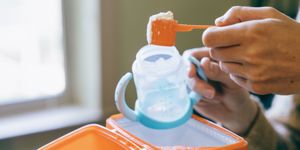Good nutrition is essential to keeping your baby happy and healthy. Feeding your baby formula can be a great option as an alternative or in addition to breastfeeding. In this article, we’ll walk you through all the basic information you need to start learning about formula feeding!
What Is Formula?
Baby formula is manufactured milk for infants that is designed to mimic the nutrients of human breast milk and is fed with a bottle. Feeding a baby formula is a safe and healthy alternative if breastfeeding isn’t an option. Parents may choose to feed their babies formula for medical or personal reasons.
Feeding formula can add convenience, as anyone can feed your baby and you may not have to feed as often since most babies digest formula slower than breastmilk. It’s a matter of personal choice, as there are many benefits to breastfeeding your baby as well.
Types of Formula
There are different types of formula available, including powdered formula, liquid concentrate, and ready-to-feed. Powdered formula is the most affordable option, and both powdered and liquid concentrate formulas need water added to them. The ready-to-feed formula comes packaged to be fed immediately but is the most expensive.
You should consider your baby’s age, dietary restrictions, and any special considerations recommended by healthcare professionals as you decide on a formula. Infant formula is regulated by the FDA and contains dozens of nutrients needed for your baby’s growth, including essential vitamins, minerals, carbohydrates, protein, and more.
The American Academy of Pediatrics recommends iron-fortified formulas and strongly discourages making formula at home as your baby may not receive all the nutrients they need. Don’t hesitate to ask your healthcare provider if you have questions about what kind of formula to get for your little one!
Preparing Formula
As you prepare formula for your infant, make sure you follow the instructions on the packaging and never dilute or microwave the formula. You should sterilize your bottles and feeding equipment to prevent contamination and ensure your baby’s health. If you want to warm the bottle, make sure to do it under running water instead of a microwave. And be sure to use or store it quickly--most formula, if stored promptly, lasts in the fridge for up to 24 hours post preparation, but consult the instructions for your specific brand to be safe.
Feeding Formula
When feeding your baby formula, pay attention to their hunger cues and feed them whenever they are hungry. You may notice them turning their head and opening their mouth, or sucking on their fist or fingers. Feeding your baby can be an opportunity to connect with them--try looking into your baby’s eyes and speaking softly to them while they eat.
Formula-fed babies should be eating around every 3 or 4 hours, but each baby is unique. Newborns should start with 1-2 ounces of formula per feeding, which gradually increases to 3-4 ounces during the first month. On average, your baby should take in about 2.5 ounces of infant formula per pound of body weight. Listen to your baby’s cues and consult your healthcare provider if you have questions about the amount of formula your infant should be eating.
As with anything regarding your baby’s health, seek support from your healthcare professionals to answer any questions about formula feeding, including which formula to use for your child, switching formula types, and how much to feed. Creating a network including other professionals such as lactation consultants and other parents who have experience with formula feeding can be another great way to find support as you navigate this exciting part of your new baby’s life.






